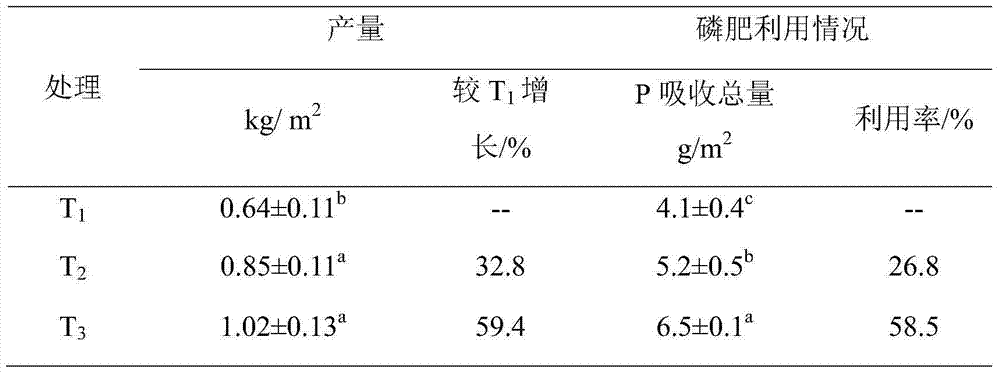High-efficiency phosphate-solubilizing bacteria and application thereof
A technology of high-efficiency phosphorus-solubilizing bacteria and phosphorus-solubilizing bacteria, applied in the field of microorganisms, can solve problems such as soil water retention decline, grassland degradation, and soil compaction, and achieve the effects of promoting root growth, increasing available phosphorus, and improving soil structure
- Summary
- Abstract
- Description
- Claims
- Application Information
AI Technical Summary
Problems solved by technology
Method used
Image
Examples
Embodiment 1
[0040] Prepare the phosphate solubilizing bacteria agent of the present invention as follows:
[0041] Activate the phosphate-solubilizing bacteria Bacillus subtilis JT-1 stored on a slant at 4°C, inoculate it on the culture medium of an eggplant-shaped culture flask (ie, the activation medium), and cultivate it for 18-24 hours. Transfer the well-grown strains to the fermentation medium, culture at 30-35°C for 12-24 hours, and obtain the fermented liquid or the dried product of the fermented liquid. The number of bacteria in the bacterial agent can reach 1×10 10 -9×10 12 CFU / g.
[0042] The medium in the described eggplant-shaped culture bottle is LB medium, and the fermentation medium component is: glucose 10g / L, (NH 4 ) 2 SO 4 0.5g / L, NaCl0.3g / L, MnSO 4 4H 2 O0.03g / L, KH 2 PO 4 1g / L, pH 6.0-8.0.
[0043]During the fermentation and cultivation process of the above-mentioned production tank, the ventilation rate of sterile air is 0.6-0.8vvm, and the stirring speed is ...
Embodiment 2
[0044] Example 2: Determination of the phosphorus solubilizing ability of bacterial strains.
[0045] Add 100mL inorganic phosphorus liquid culture medium respectively in 500mL Erlenmeyer flask, medium composition is glucose 10g / L, (NH 4 ) 2 SO 4 1g / L, MgSO 4 ·7H 2 O0.3g / L, NaCl0.3g / L, FeSO 4 ·7H 2 O0.03g / L, MnSO 4 4H 2 O0.03g / L, Ca 3 (PO 4 ) 2 5.0g / L. Then inoculate 1 mL of bacterial suspension, and do not inoculate control (add 1 mL of sterile water to the culture medium) at the same time, and repeat all treatments 3 times. Shake culture at 30°C and 150rpm for 7 days, centrifuge the culture solution at 6000rpm for 20min, measure the amount of phosphorus solution (water-soluble phosphorus content) by molybdenum antimony colorimetric method, and it is 682.43-725.28mg / L, and the phosphorus solution rate is 68.2% -72.5%. Phosphorus solubilizing bacteria JT-1 has a higher ability to solubilize phosphorus.
Embodiment 3
[0046] Example 3: Phosphorus solubilizing bacteria can improve crop yield.
[0047] The fermentation preparation of phosphate solubilizing bacteria agent is basically the same as embodiment 1.
[0048] Taking the rice in the plot as the experimental object, the test set up 2 treatments, the dosage of which was 30kg / hm without adding the phosphate-dissolving bacteria agent (T1) and adding the phosphate-dissolving bacteria agent (T2) 2 , each treatment was repeated 3 times, the length of the plot was 8m, the width was 3m, and the area of the plot was 24m 2 , Protective rows were set up around the community, except for the application of phosphate solubilizing bacteria, the other management measures such as fertilization and watering were the same for the two treatments.
[0049] Table 1. Effects of each treatment on rice yield and its components
[0050]
[0051] It can be seen from Table 1 that the phosphorus-dissolving bacteria agent can significantly increase the effec...
PUM
 Login to View More
Login to View More Abstract
Description
Claims
Application Information
 Login to View More
Login to View More - R&D
- Intellectual Property
- Life Sciences
- Materials
- Tech Scout
- Unparalleled Data Quality
- Higher Quality Content
- 60% Fewer Hallucinations
Browse by: Latest US Patents, China's latest patents, Technical Efficacy Thesaurus, Application Domain, Technology Topic, Popular Technical Reports.
© 2025 PatSnap. All rights reserved.Legal|Privacy policy|Modern Slavery Act Transparency Statement|Sitemap|About US| Contact US: help@patsnap.com



